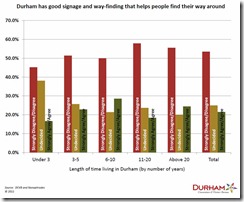Communities such as Durham, with innovation intertwined deep in their DNA, can, like humans, also suffer from attention deficit. When I observe this, it reminds me of how an organizational behavior consultant helped me understand a trait that was inhibiting the success of one of my staff members in an organization I managed in another city nearly 30 years ago.
An organizational psychologist from RHR, a management consulting firm, helped me understand that a staff member of mine did not carry knowledge, experience or learning from one project to another as I wanted because he viewed each project as a silo.
Sometimes innovative communities suffer from what looks like attention deficit because they never seem to fully exploit the success of a project by populating it to the entire community and instead leave them stored or “siloed” while they hurry on to the next panacea usually accompanied by some related matching grant.
Neglect of roadsides and medians is actually one of only two areas where Durham's internal stakeholders give the community overall a negative rating in scientific surveys. The other negative-to-positive ratio is for street signage and wayfinding.
Communitywide wayfinding was first proposed to the community in the mid-90s. Impatient for officials to grasp a more holistic approach, and to his credit, the head of Durham's downtown advocacy organization and a friend successfully pushed wayfinding into a plan to update street amenities in one of his downtown neighborhood’s five districts. It has slowly been populated to the other four but not communitywide where it is the most needed.
But as successful as wayfinding has been in that one tiny geographic area and as inexpensive as it would be now to populate throughout the city and county, community leaders have left it siloed there while other communities in this state and across the nation have leapfrogged them to a countywide approach.
One can speculate on the reason why communities silo projects. Often there is a lack of an overarching strategic direction. Instead, officials seem to become addicted to anger-fueled adrenaline fixes or grant-chasing and neglect to grasp that something successfully implemented in one area can be extended even more cost effectively to have an even greater effect communitywide.
As has been incorrectly surmised about roadway neglect, one might expect that negative resident opinion scores on Durham’s street signage and wayfinding might be driven by newcomers, especially because Durham is rated so highly and consistently as a place to live, work and to business as well as visit.
But that isn't the case. While residents who have lived here three years or less give street signs/wayfinding a 3 to 1 negative to positive ratio with nearly 40% unsure, the percentage of residents who have been here 11 to 20 years show an increased negative rating up from 45% to nearly 60% and less than 25% are unsure.
The state transportation executive was definitely mistaken when he told me two decades ago that Durham didn't need a correction to some inaccurate signs because “anyone here already knew where they were going.”
Communities such as Durham with a highly irregular road pattern, a terrain of never-ending hills and dales and a heavy tree canopy, but with no singular defining features such as a broad river or mountains, are in desperate need of a coherent communitywide system of wayfinding signs that will also simultaneously eliminate up to half of existing sign clutter.
There are few if any other improvements that will make such a dramatic impact on the day-to-day lives of people who live in a community or commute to work or travel here to visit than coherent communitywide wayfinding.
For Durham the hard part has already been done. Taking a solution that has already been show to be successful in one neighborhood and extending it throughout the community as a whole does not have to be as complex as noted last week by Emily Badger in Atlantic Cities.
And as my friend and fellow blogger Bill Baker recommended when he guided me to Badger’s post, Durham's need for communitywide wayfinding has already been identified in what he calls visitor readiness reports by Durham's official community-destination marketing organization as a top priority for increasing Durham's visitor-centric cultural and economic development.
For officials this means that populating Durham's wayfinding across the community will be self-funded by the growth it helps spawn to the nearly $40,000,000 that visitor spending generates each year in local tax revenues that are then split by the City and County.
This includes the nearly $4 million in City and County general funds that is clearly eligible to be used to fund wayfinding under North Carolina General Assembly guidelines for local use of revenues from a special tax paid by overnight visitors.
1 comment:
If you have a notice via the Internal Revenue Service and you are terrified to contact the Internal Revenue Service this web site http://www.tax-defense-network-cpnotices.com/cp-notice/understand-irs-notices/ will help you determine the very best plan of action, how to accurately reply, and how to repay your debt.
Post a Comment